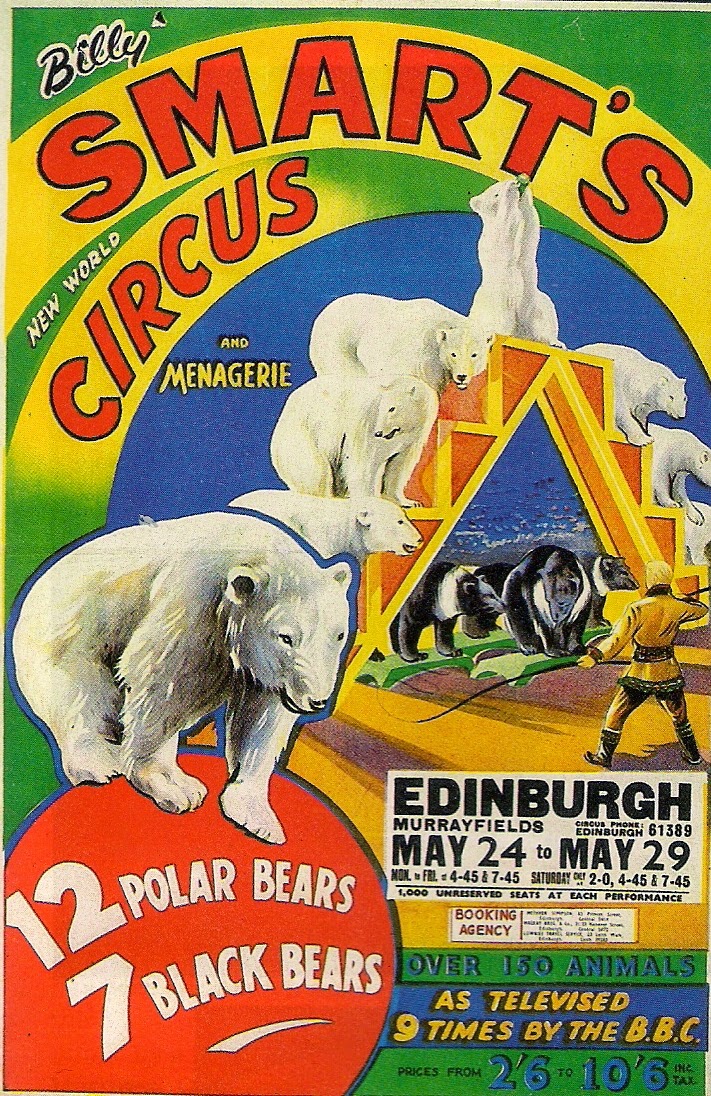The following is an edited version of an article that Circus Mania author Douglas McPherson wrote in The Stage.
 |
| No such thing as bad publicity? - How the Daily Mail greeted the Great British Circus' decision to reintroduce elephants to the circus ring in 2009 |
Last year’s conviction of Bobby Roberts for failing to prevent an employee beating Anne, a retired elephant owned by Bobby Roberts Super Circus, was just the latest example of how circus only ever seems to hit the headlines when allegations of cruelty are involved. Even at local newspaper level, reports of a circus’ arrival in town inevitably focus on demonstrations by animal rights protestors.
 |
| In the 1950s polar bears and black bears were a circus' biggest draw |
So when did the nation that invented the modern circus fall out of love with juggling bears and footballing dogs?
The circus as we know it was founded in London in 1768 by Philip Astley, a cavalry officer turned trick rider who performed equestrian displays on land to the south of Westminster Bridge. Astley established the still standard size of the circus ring as 42 feet in diameter, that being the optimum space for bringing a circling horse to a gallop and creating the centrifugal force that allowed him to perform tricks standing on its back.
Before the advent of television, circus animals played an educational role. If you lived in an English village at a time when foreign travel was a rarity, where else but in a travelling menagerie would you see sea-lions and leopards?
During the 70s and 80s, a waning of interest in circus was accompanied by an increasing concern among the general public about the treatment of performing animals, not just in circus but in TV and film.
Sensitive to the growing voice of the animal rights movement, local councils began banning circus animals from municipal showgrounds in the early 90s. Forced onto privately owned land in less prominent locations, the circuses found business further damaged by picket lines of animal rights protestors.
Gerry Cottle, the biggest circus name of the 80s, responded by closing his animal circus and promoting the all-human Moscow State Circus and Chinese State Circus. On the global stage, Canada’s Cirque du Soleil emerged from the all-human ‘new circus’ movement to become the most successful circus company in history.
Yet, despite a bad press that was keeping the wider public away, circuses with animals continued.
 |
| When Bobby Roberts stood trial over Anne the Elephant, The Guardian commissioned Circus Mania author Douglas McPherson to write this article about animals in the circus. |
Others say they are giving their audiences what they want. Zippos, for example, operated an all-human show for its first ten years. At a point when most circuses were giving up their animals Zippos introduced horses, dogs and birds because of customer demand.
Circus trainers have always maintained that their methods rely on patience and reward. According to Britain’s last tiger trainer, Martin Lacey, “It’s organised play and if they don’t want to play you have a problem. You have to be rather nice to them.”
Since 1932 there have been seven prosecutions of circus trainers. But proven instances of cruelty, such as Mary Chipperfield’s 1999 conviction on 12 counts of cruelty to a chimpanzee, have received such widespread media coverage as to be disproportionately damaging to the image of the circus generally.
In addition to training methods, animals rights groups such as Born Free criticise cage sizes, transportation conditions and the keeping of animals in inappropriate social groups.
 |
| Circus Mania author Douglas McPherson talks about circus animals in the BBC documentary 'The last circus elephant.' |
Lacey celebrated the report’s findings by importing a German elephant act to his Great British Circus. Within months, he must have reconsidered his view that there’s no such thing as bad publicity when TV news broadcast undercover film made by welfare group Animal Defenders International that showed the elephants being beaten by a groom.
The groom was dismissed by the circus before the film was released. But although no prosecutions were made, the war with the protestors was being lost in the media.
In March 2012, animal welfare minister Lord Taylor announced that the government will ban travelling circuses from using wild animals in 2015, with a new licensing and inspection regime introduced in the interim. But whether there will be any wild animals in British circuses left to ban is another matter.
 |
| The Great British Circus closed in 2012 |
Whether Britain’s other five remaining circuses with animals will similarly fade away or continue with just the horses and dogs that the law will allow remains to be seen.
But, around the world, the circus animals debate is far from over. In Las Vegas, the until-now all-human Cirque du Soleil recently augmented its illusion show Believe... with its first live elephant.
"Circus Mania is a brilliant account of a vanishing art form."
- Mail on Sunday.
 |
| Thomas Chipperfield and Tsavo the lion - the last big cat act in the UK, currently appearing with Peter Jolly's Circus |
When Martin Lacey closed his Great British Circus, it looked as though Britain's last big cats had left the big top. At the end of 2013, however, Thomas Chipperfield brought his lions and tigers from Tom Duffy's Circus in Ireland and joined Peter Jolly's Circus - one of only two English circuses licensed to show wild animals. Chipperfield is currently the last big trainer in the UK, and with the Government's Wild Animals In Circuses Bill due to pass through Parliament in the coming year and bring next year's proposed ban into force, he may well be the last. Click here to read my review of Peter Jolly's Circus.

No comments:
Post a Comment